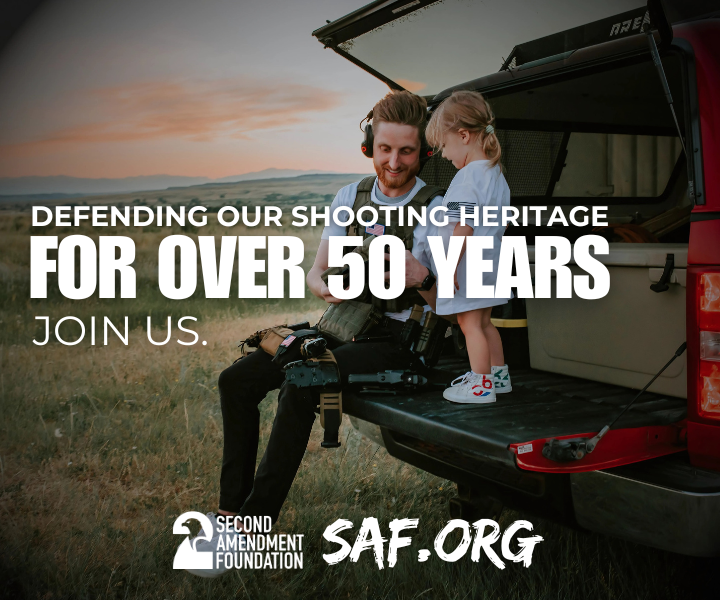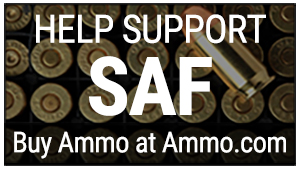
By Dave Workman
Editor-in-Chief
For those of us who spend a great deal of time off the pavement and away from any semblance of civilization, where the campfire is a main source of light and heat, and things actually do go bump in the night, a reliable sidearm is considered a necessity.
Especially in the West, where—depending upon the location—one might encounter “things with teeth” which might include a hungry mountain lion or a bear, black or grizzly, with a mean disposition, the presence of a handgun of adequate caliber can be a Godsend in an emergency. At such moments and in such situations, one instantly understands the clear logic behind the adage, “It is better to have a gun and not need it, than to need a gun and not have it.”
With the camping/hiking/backcountry fishing and exploring seasons beginning to unfold, it’s as good a time as any to consider a sidearm for off-pavement carry, especially in places where you just might encounter something unpleasant.

In the wilds, which one finds anywhere from Maine to the Alaska Interior, emergencies all have a common denominator: Help is not coming immediately, if at all, and you are on your own.
There are so many handgun options available, and over the years I’ve encountered people trying literally all of them, from hikers carrying small pocket pistols to people in bear country packing a .44 Magnum or something heftier, such as the .454 Casull, .460 or .500 Smith & Wesson, .475 Linebaugh or .480 Ruger, the choice of hardware really does boil down to personal preference.

One should be prepared for tremendous recoil with any of these monster calibers, and the worst I’ve experienced has been with the .454 and .460, while some years ago I was testing a Ruger Alaskan in .480 with a short barrel, and it was actually not that difficult to control. It was accurate as well out to roughly 100 yards.
We’ve heard and read stories about people in Alaska defending themselves against interior grizzlies with 9mm or .45 ACP pistols, and coming out on top. On the other hand, I interviewed a musher who encountered an angry bull moose and all she had was a .380 ACP, which really didn’t impress the critter as it stomped her sled. A friend showed up with a rifle to put the animal down.
There have been two cougar attacks in my region over the past few years, one fatal and the other just injurious, and nobody had a gun. In one of the incidents, the big cat was actually trapped and held down by some people using a trail bike, and a wildlife officer finally arrived to dispatch the critter.

Once or twice while hunting solo in Washington’s Cascades or Kettle Range, I’ve had heavy-breathing nocturnal visitors wander through my camp, and having a sixgun within reach inside the tent was always reassuring. I don’t keep food inside the tent, either.
Over the years, I have armed up with a variety of guns in different calibers, all capable of stopping small game and big unpleasantness. Yes, even a .22-caliber revolver or semi-auto is better than having no gun at all, and may years ago I read a report in one of the popular outdoor periodicals about a fellow who was treed by a rather large black bear and he actually dispatched the bruin with a head shot from a .22.
My typical gear comes in three calibers:
- A .357 Magnum revolver, either Colt or S&W. The caliber is capable of putting down an elk, deer, black bear, cougar, bobcat or a predator of the two-legged variety. In the backcountry, my .357 wheelguns will be stoked with handloads, using either a 125- or 158-grain jacketed hollowpoint propelled by either Hodgdon H110 or Alliant 2400 (the latter being in impossibly low supply for the past couple of years).
- The .41 Magnum, which shoots a bit flatter but hits just as hard as the better-known and more widely used .44 Magnum. One experiences a little less recoil from the .41 Magnum even when using comparable loads, and my typical load—with which I’ve taken three deer over the years—is a 210-grain JHP over a less-than-maximum charge of H110. Lately, I’ve also been experimenting with lead semi-wadcutter-type bullets weighing 215 and 225 grains, with decent results.
- The .45 Colt, a legendary sixgun caliber introduced 150 years ago and still going strong, thanks to modern propellants and bullet design, is my other option. My feature on reloading the .45 Colt is appearing in the current issue of GUNS Magazine, with a focus on two powder choices—Hodgdon HP38 and CFE Pistol—and two bullets from Hornady, the 250-grain XTP and 255-grain lead flatpoint. The .45 has an impressive frontal mass, and when it travels along in the 800-900 fps velocity range, it has a proven terminal result.
One of my pals has a .44 Magnum Ruger Blackhawk, which he loads up with 240-grain JHPs. It is a stainless specimen and shoots rather well. The .44 Magnum is a proven game stopper, and so many handguns are chambered for this cartridge by Colt, S&W, Ruger, Taurus and others the choices are abundant. For backcountry work, I always recommend heavier bullets, especially in bear country.
And I’ve had favorable experience with guns in .44 Special, and one of the stoutest specimens was a Ruger GP100 (pictured above). Never sell this old cartridge short. It’s as much a powerhouse as the .45 Colt, and makes a sizeable hole in anything it hits.

Only a few weeks ago, S&W and Lipsey’s announced a return of two Mountain Gun options, both produced without the annoying-to-some-people internal safety locking system. One is a .44 Magnum and the other a .357 Magnum. Both are stainless steel double-action wheelguns with adjustable sights tapered barrels (to save weight) and they are fitted with hardwood grips.
The .44-caliber Mountain Gun is built on the famous S&W “N”-frame, while the .357 Magnum is offered on the company’s “L”-frame, and it holds seven cartridges.
What about single-or double-action? I use one or the other and this is also a matter of personal choice. My single-action Ruger New Vaquero sixguns both have very good actions, right out of the box. Neither has been tinkered with by a gunsmith, and they shoot rather accurately out beyond 100 yards if necessary.

My magnum choices are all double-action guns, and all but one wears the S&W brand. My vintage Colt Python goes afield now and then, since it was never intended to become a safe queen, and a couple of years ago, I discovered it particularly likes a handload topped by a 158-grain JHP over a charge of H110.
Being a traditionalist, I prefer leather holsters and cartridge belts while other folks may prefer some hard synthetic or soft nylon. More power to them; I just think leather is a material for all seasons. I’ve never had a leather holster crack on me in cold weather, nor did one come apart. Again, this is a personal choice issue, so choose what suits your personal needs.

The advantage of a sidearm, as opposed to a rifle or shotgun, in the backcountry for camping, fishing or day-hiking should be obvious. The holstered handgun is always within reach, and leaves one’s hands free for other chores. This cannot be said for the long gun, which may be several feet away when an emergency arises.
While one size doesn’t necessarily fit all, the sidearm does address the most important consideration of all: to have a gun handy when it is needed immediately.


